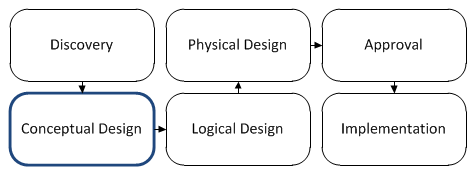During the vSphere design discovery process, information is collected on the business and technical goals of the virtualization project. This information must be analyzed in order to determine the vSphere design factors.
The vSphere design factors that must be determined are as follows:
- Requirements
- Constraints
- Assumptions
- Risks
Determining the requirements, making and proving assumptions, determining constraints, and identifying risks forms the conceptual design and provides the foundation to build on for the logical design. Business and technical design factors that are identified as part of the conceptual design will be mapped to the resources that are necessary to satisfy them during the logical design process. The conceptual design phase is highlighted within the overall design and implementation flow diagram:

In our example design, after conducting interviews with stakeholders and performing technical assessments of the environment, the following information has been collected about the project's goals, current environment, and business factors that will influence the design:
- Currently, there are 100 physical servers, each hosting a single application. Each application services 10 customers.
- The business expects to add 50 new customers over the next year.
- The solution must support growth over the next 5 years.
- Application uptime and accessibility is very important.
- Consolidate physical servers to reduce hardware costs associated with the maintenance and deployment of new application servers.
- No more than 20 application servers, or 200 customers, should be affected by a hardware failure.
- There should be a 1-hour maintenance window each month for application and hardware maintenance. Hardware maintenance is currently a challenge. Since hardware and application maintenance cannot be performed at the same time, the maintenance window does not typically provide the time that's required to perform both application and hardware maintenance.
- Application servers run Microsoft Windows 2016 as the operating system.
- Each application server is configured with 8 GB of memory. The peak usage of a single application server is approximately 65 percent or approximately 5.2 GB.
- Each application server is configured with two dual-core 2.7 GHz processors. The peak usage of a single application server is approximately 10 percent of the total processing power, or approximately 1 GHz.
- Each application server is configured with 100 GB of disk space. Peak disk capacity usage of a single application server is approximately 65 percent of the total disk space, or 65 GB. Peak disk performance of a single application server is 50 IOPS with an IO profile of 90 percent read and 10 percent write.
- Currently, the stakeholders are using HP DL380 servers. The infrastructure team is very familiar with the management and maintenance of these servers and wants to continue using them.
- Currently, there is no shared storage. The current system and infrastructure administrators are unfamiliar with the shared storage concepts and protocols.
- Cisco switches are used for network connectivity. Separate VLANs exist for management connectivity and production application connectivity.
- Currently, each physical server contains a single gigabit network interface card. Peak network usage is 10 Mbps.
- Server logs are auditable and must be retained for 6 months. All logs should also be sent to a central syslog server that is already in place.
- If an application server fails, the current recovery time is around 8 hours. The solution should reduce this time to less than 4 hours.
- The management team expects the implementation to be completed before the third quarter of the year.
- There is an approved project budget of $200,000.
In this chapter, we will use this information to determine the design factors so that we can create the conceptual design. Throughout the design process, each design decision is mapped back to these design factors.
In this chapter, we will cover the following topics:
- Identifying design requirements
- Identifying design constraints
- Making design assumptions
- Identifying design risks
- Considering infrastructure design qualities
- Creating the conceptual design
